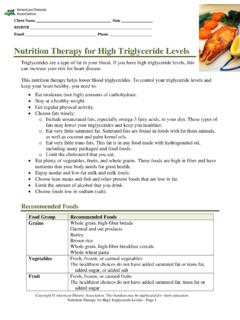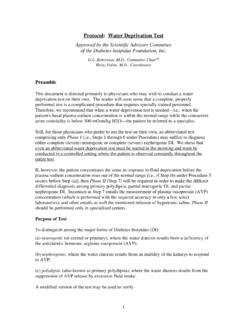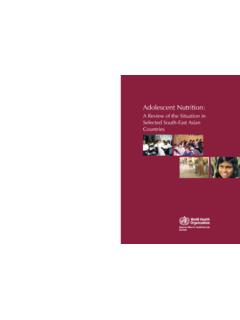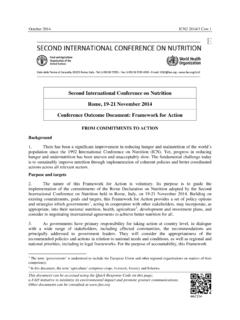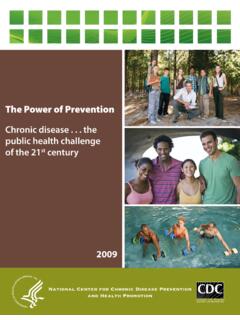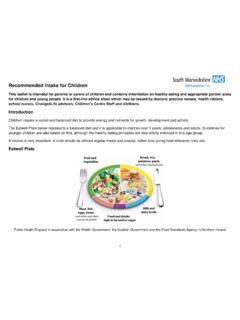Transcription of NCC Pediatrics Continuity Clinic Curriculum: Nutrition III ...
1 NCC Pediatrics Continuity Clinic Curriculum: Nutrition III: School-Age & Adolescent Faculty GuideGoal: To understand the Nutrition recommendations and key issues for school-age children and adolescents, and to be able to translate them into practical, anticipatory guidance for parents. * Note: Obesity will be covered separately in the Nutrition IV Preparation: Read School-Age & Adolescent Nutrition (Excerpts from ) Skim Vegetarian Diets in Children and Adolescents (PIR, 2009) Skim Eating Disorders (PIR, 2016) Be prepared to provide a case-example or FAQ related to School-Age & AdolescentNutrition from your Clinic experience. Discuss how you approached the case/ Agenda: Review Nutrition III Quiz Complete Nutrition III Cases Round table discussion of resident School-Age & Adolescent casesPost-Conference: Board Review Q&A Extra Credit: Please review the following enclosures, related to the practical guidelines, above: AAP Clinical Report on Eating Disorders ( Pediatrics , 2010) Planning Well-Balanced Vegetarian Diets in Infants, Children, and Adolescents: TheVegPlate Junior (Journal of the Academy of Nutrition and Dietetics, July 2019) Managing Feeding Disorders and Feeding Problems (PIR, 2013) Vitamin Deficiency & Overdose Chart (helpful for Board Review questions)Edited by J.
2 McDonnell, 2016. Updated C. Carr, 2018, 2019, Nutrition Material adapted from: Calories & Servings As the middle years progress, children's total energy needs will increase and thus their food intake will rise, especially as they approach puberty. Between ages 7 and 10, both boys and girls consume about 1,600 to 2,400 calories per day. Most girls experience a significant increase in their growth rate between ages 10 and 12 and will take in about 200 calories more each day, while boys go through their growth spurt about 2 years later and increase their food intake by nearly 500 calories a day. Some parents worry that throughout the school age years, there seems to be no rhyme or reason to their children s appetite. Appetites can vary, even from day to day, depending on factors like activity levels. A child who spends the afternoon doing homework, for example, may have fewer caloric needs than one who plays outdoors after school.
3 At the same time, children in this age group eat for a lot of reasons besides hunger. They could be upset or tired and relying on food for comfort. When your youngster says that he s hungry and it s not a regular meal or snack time, try to determine whether food might be serving some other purpose. Then help him find an activity that will keep him occupied doing something productive. Ultimately, children in early to middle adolescence should be gaining 4 to 7 lbs per year. As long as your child is growing normally, keep your focus on serving a variety of healthy foods. Variety & Nutrients Your child should consume a variety of foods from the five major food groups that make up the "Food Plate developed by the Department of Agriculture in July 2011, to replace the Food Pyramid . Vegetables: 3-5 servings/day. Serving = 1 cup of raw leafy ve gs, 3/4 cup of veg juice, or 1/2 cup of other vegs, chopped raw or cooked.
4 Fruits: 2-4 servings/day. Serving = cup sliced fruit or a medium-size whole fruit. Bread, cereal, or pasta: 6-11 servings/day. Serving = 1 slice of bread, cup of rice/pasta, or 1 oz of cereal. Protein foods: 2-3 servings of 2-3 oz of cooked lean meat, poultry, or fish per day. Serving also = cup of cooked dry beans, 1 egg, or 2 TBSPs of peanut butter for each oz lean meat. Dairy products: 2-3 servings/day of 1 cup of low-fat milk or yogurt, or oz of natural cheese. Foods to Reduce: Fat: High fat intake, particularly saturated fats (solid at room temp), can increase cholesterol andlead to coronary artery disease. After age 2, children should be served foods lower in saturatedfats ( poultry, fish, lean meat not fried; low-fat dairy; low-saturated-fat oils; soft margarine not butter; limited eggs). In general, fats should make up <30% of calories in a child s diet,with >2/3 of those fat calories coming from unsaturated fats (liquid at room temp corn,safflower, sunflower, soybean, and olive oil).
5 Sugar: Many children consume sugar in great quantities, usually at the expense of healthierfoods ( sodas and juice, instead of milk or water). Keep consumption at moderate levels. Salt: The habit of using extra salt is acquired. Thus, as much as possible, serve a child food lowin salt, to decrease the risk of high blood pressure. Use herbs, spices, or lemon juice to flavorfoods and avoid processed foods such as cheese, instant puddings, canned vegetables and soups,hot dogs, salad dressing, pickles, and potato Supplements are rarely needed in middle childhood, since a balanced diet contains sufficient quantities for the essential vitamins and minerals. However, children with poor appetite, erratic eating habits, or highly selective diets ( vegetarian or vegan) may need vitamin supplements. Over-the-counter supplements ( Flintstones chewables or gummies) are generally safe; however, if taken in excessive amounts or combined, some particularly fat-soluble vitamins (ADEK) can be toxic.
6 Of note, mega-vitamin therapy or orthomolecular medicine in which vitamins are given in extremely large doses for conditions ranging from the common cold to hyperactivity has no proven scientific validity and may pose risks. Following are some of the vitamins and minerals necessary for normally growing children, and some of the foods that contain them. (Review this Vitamin Deficiency & Overdose Chart chart for a more complete list of vitamins and the conditions associated with deficiency or excessive intake). Vitamin A promotes normal growth, healthy skin, and tissue repair, and aids in night and colorvision. Rich sources include yellow vegetables, dairy products, and liver. B vitamins promote red blood cell formation and assist in a variety of metabolic activities. Foundin meat, poultry, fish, soybeans, milk, eggs, whole grains, and enriched breads and cereals.
7 Vitamin C hastens the healing of wounds and increases resistance to infection. Found in citrusfruits, strawberries, tomatoes, potatoes, Brussels sprouts, spinach, and broccoli. Vitamin D promotes tooth and bone formation and regulates calcium absorption. Sources includefortified dairy products, fish oils, fortified margarine, and egg yolks. Sunlight also contributes todietary sources of vitamin D, stimulating the conversion in the Nutrition Material adapted from: Calories & Servings The body demands more calories during early adolescence than at any other time of life. On average, boys require about 2800 calories per day; and girls, 2200 calories per day. Typically, the ravenous hunger of adolescence starts to wane once a child has stopped growing, though not always. Kids who participate in physical activity will still need increased amounts of energy into late adolescence.
8 Serving sizes for teenagers should still be about the same as they are for adults. Please review the chart on the following page to see the number of servings and sizes recommended for the average teen. The USDA Food Plate can still be used as a visual guide. Food Group Number of Servings Per Day Females Males Calories Aged 11-24 Total Calories: 2,200 Aged 11-14 Total Calories: 2,500 Aged 15-18 Total Calories: 3,000 Aged 19-24 Total Calories: 2,900 Bread, Cereal, Rice and Pasta Group 6- 11 servings9 servings 11servings Milk, Yogurt and Cheese Group 4- 5 servings4 or 5 servings Aged 11-18: 4 or 5 servings Aged 19-24: 2-3 servings Vegetable Group 3- 5 servings4 servings 5 servings Fruit Group 2- 4 servings3 servings 4 servings Meat, Poultry, Fish, Dry Beans, Eggs and Nuts 2- 3 servings6 ounces total 7 ounces total Total Fat 73 grams Aged 11-14: 83 grams Aged 15-18: 100 grams Total Added Sugar 12 teaspoons 18 teaspoons Variety & Nutrients There are a number of obstacles to balanced adolescent Nutrition : Skipping meals.
9 According to a recent poll, about of boys and girls aged 9-15 years said thatthey didn t eat breakfast on school mornings. Breakfast-to-go options include a bagel and peanutbutter, a hard-boiled egg, nuts & raisins, a yogurt, or an apple. Snacking: 1/3 of the caloric intake of adolescents comes from snacks particularly unhealthyones. It s therefore important to keep the refrigerator and pantry stocked with healthy optionslike low-fat cheeses, applesauce, air-popped popcorn, and baked potato chips. Eating away from home: At school, adolescents will often settle for a stop at the vendingmachine for lunch. After school, they may decide that fitting in with their peers at a fast-foodrestaurant or pizza shop is more important than making healthy food selections. Brainstormhealthy alternatives and/or other activities to do with their peers.
10 The lure of fad diets: As teenage girls hopscotch from one fad diet to another, good nutritionmay fall by the wayside. Reinforce that these diets are too restrictive and unhealthy and bad forweight loss in the long guidance in the above section for Foods to Reduce still applies to adolescents. Also remember, each gram of protein and carbohydrates supplies 4 calories, whereas fat contributes 9 calories/gram. Vitamins Adolescents particularly girls, who eat roughly 25% fewer calories per day than boys tend to fall short of their daily quotas of vitamins and minerals. Calcium, iron and zinc are most vulnerable. Calcium: Adolescence provides a window of opportunity for avoiding osteoporosis later in life. During the teenage years, the growing bones absorb more calcium from the blood than at any other time of life. By early adulthood, our bones stop accepting deposits, and not long after, the gradual loss of calcium begins.
